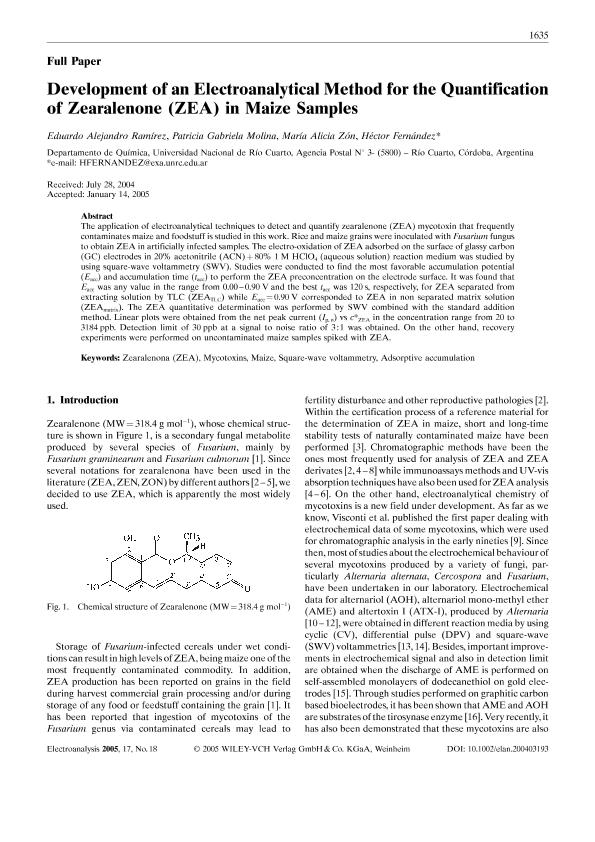Artículo
Development of an electroanalytical method for the quantification of zearalenone (ZEA) in maize samples
Fecha de publicación:
09/2005
Editorial:
Wiley VCH Verlag
Revista:
Electroanalysis
ISSN:
1040-0397
e-ISSN:
1521-4109
Idioma:
Inglés
Tipo de recurso:
Artículo publicado
Clasificación temática:
Resumen
The application of electroanalytical techniques to detect and quantify zearalenone (ZEA) mycotoxin that frequently contaminates maize and foodstuff is studied in this work. Rice and maize grains were inoculated with Fusarium fungus to obtain ZEA in artificially infected samples. The electro-oxidation of ZEA adsorbed on the surface of glassy carbon (GC) electrodes in 20% acetonitrile (ACN) + 80% 1 M HClO4 (aqueous solution) reaction medium was studied by using square-wave voltammetry (SWV). Studies were conducted to find the most favorable accumulation potential (Eacc) and accumulation time (t acc) to perform the ZEA preconcentration on the electrode surface. It was found that Eacc was any value in the range from 0.00-0.90 V and the best tacc was 120 s, respectively, for ZEA separated from extracting solution by TLC (ZEATLC) while Eacc = 0.90 V corresponded to ZEA in non separated matrix solution (ZEAmatrix). The ZEA quantitative determination was performed by SWV combined with the standard addition method. Linear plots were obtained from the net peak current (I p, n) vs c*ZEA in the concentration range from 20 to 3184 ppb. Detection limit of 30 ppb at a signal to noise ratio of 3:1 was obtained. On the other hand, recovery experiments were performed on uncontaminated maize samples spiked with ZEA.
Archivos asociados
Licencia
Identificadores
Colecciones
Articulos(CCT - CORDOBA)
Articulos de CTRO.CIENTIFICO TECNOL.CONICET - CORDOBA
Articulos de CTRO.CIENTIFICO TECNOL.CONICET - CORDOBA
Citación
Ramírez, Eduardo Alejandro; Molina, Patricia Gabriela; Zón, María Alicia; Fernández, Héctor; Development of an electroanalytical method for the quantification of zearalenone (ZEA) in maize samples; Wiley VCH Verlag; Electroanalysis; 17; 18; 9-2005; 1635-1640
Compartir
Altmétricas




